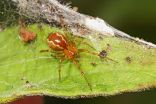(Press-News.org) Teens who received free contraception and were educated about the pros and cons of various birth control methods were dramatically less likely to get pregnant, give birth or get an abortion compared with other sexually active teens, according to a new study.
The research, by investigators at Washington University School of Medicine in St. Louis, appears Oct. 2 in the New England Journal of Medicine.
The study promoted the use of long-acting forms of birth control, such as intrauterine devices (IUDs) and implants, because of their superior effectiveness in preventing unintended pregnancies. Among the 1,404 teens enrolled in the Contraceptive CHOICE Project, 72 percent opted for IUDs or implants. This compares with an estimated 5 percent of U.S. teens who choose long-acting birth control.
In the United States, most teens opt for less-reliable contraceptives such as birth control pills or condoms or no method at all because of cost and other factors.
"When we removed barriers to contraception for teens such as lack of knowledge, limited access and cost in a group of teens, we were able to lower pregnancy, birth and abortion rates," said Gina Secura, PhD, the study's first author and director of the CHOICE Project. "This study demonstrates there is a lot more we can do to reduce the teen pregnancy rate."
From 2008-13, the annual pregnancy rate of teens ages 15-19 in the study averaged 34 per 1,000, compared with 158.5 per 1,000 in 2008 for sexually active U.S. teens. During the five-year span, the average annual birth rate among teens in the study was 19.4 per 1,000, compared with 94 per 1,000 in 2008 for sexually active U.S. teens.
The abortion rate among teens in the study also dropped dramatically. From 2008-2013, their average annual abortion rate was 9.7 per 1,000, compared with 41.5 per 1,000 in 2008 for sexually active U.S. teens.
"The difference in pregnancy, birth and abortion rates between teens enrolled in the Contraceptive CHOICE Project and U.S. teens is remarkable," said Jeffrey Peipert, MD, PhD, principal investigator of the CHOICE Project and the Robert J. Terry Professor of Obstetrics and Gynecology.
Among teens in the study, almost 500 were minors ages 14-17 when they enrolled. Half of these minors reported having had a prior unintended pregnancy, and 18 percent had had at least one abortion.
Although the teen pregnancy rate in the United States has declined in the past two decades, it remains far higher than in other industrialized countries. Each year, more than 600,000 teens in the United States become pregnant, with three in 10 teens becoming pregnant before they turn 20.
In addition to the negative health and social consequences suffered by teen mothers and their children, U.S. teen births cost almost $10 billion annually in public assistance, health care and lost income, according to The National Campaign to Prevent Teen and Unplanned Pregnancy in 2010.
AUDIO:
Washington University researchers are reporting that education, access and cost seem to be keys to preventing unplanned pregnancies. They report that teen-aged women who received contraception at no cost and...
Click here for more information.
The researchers analyzed data on teens enrolled in the Contraceptive CHOICE Project, a study of more than 9,000 St. Louis women and adolescents at high risk for unintended pregnancy and willing to start a new contraceptive method. Participants had their choice of a full array of birth control options, ranging from long-acting contraceptives such as IUDs and implants to shorter-acting forms like birth control pills, patches, rings, condoms or natural family planning. The teens then were followed for two to three years.
This study supports results from a previous study of the Contraceptive CHOICE Project that determined that providing birth control at no cost substantially reduced unplanned pregnancies and cut abortion rates by a range of 62-78 percent compared with the national rate.
Teens in the current study who chose IUDs or implants continued to use them longer than those who opted for shorter-acting methods such as the pill. Two-thirds of teens in the study still were using IUDs and implants at 24 months after beginning their use compared with only a third of teens still using shorter-acting methods such as birth control pills.
"We were pleasantly surprised by the number of teens choosing IUDs and implants and continuing to use them," Peipert said. "It's exciting that this study could provide insight into how to tackle this major health problem that greatly affects teens, their children and their communities."
Teen pregnancy has been designated by the U.S. Centers for Disease Control and Prevention as one of the six Winnable Battles because of the magnitude of the problem and the belief that it can be addressed by known, effective strategies. The Winnable Battle target is to reduce the teen birth rate by 20 percent ,from 37.9 per 1,000 teens in 2009 to 30.3 per 1,000 teens by 2015.
INFORMATION:
Secura GM, Madden T, McNicholas C, Mullersman J, Buckel CM, Zhao Q and Peipert JF. Provision of no-cost, long-acting contraception and teenage pregnancy. New England Journal of Medicine. Oct. 2, 2104.
Washington University School of Medicine's 2,100 employed and volunteer faculty physicians also are the medical staff of Barnes-Jewish and St. Louis Children's hospitals. The School of Medicine is one of the leading medical research, teaching and patient-care institutions in the nation, currently ranked sixth in the nation by U.S. News & World Report. Through its affiliations with Barnes-Jewish and St. Louis Children's hospitals, the School of Medicine is linked to BJC HealthCare.
Teen pregnancies, abortions plunge with free birth control
2014-10-02
ELSE PRESS RELEASES FROM THIS DATE:
B and T cell-targeting drug ameliorates chronic graft-versus-host disease in mice
2014-10-02
Hematopoietic stem cells (HSCs) can differentiate into all types of blood cells, including red blood cells and immune cells. While HSC transplantation can be life saving for patients with aggressive forms of blood cancer that are unresponsive to other available treatments, there are many risks associated with the procedure. For example, graft verse host disease (GVHD) results when immune cells generated from donor HSCs attack host tissue. Chronic GVHD occurs over time and is characterized by fibrosis, which impairs organ function. A new study in the Journal of Clinical ...
Clinical trial evaluates heterologous prime/boost regimens in preventative HIV vaccination
2014-10-02
Almost 40 million people worldwide live with HIV/AIDS, with an estimated 2.5 million new cases per year. Therefore, there has been a large global effort to develop an effective vaccine against the virus. HIV-1 vaccine development has been challenging but recent clinical trials have been promising. A new study in the Journal of Clinical Investigation discusses the results from a clinical trial that evaluated the immune response following different HIV vaccine regimes. Nicole Frahm and colleagues tested prime-boost regimes combining a New York vaccinia HIV clade B (NYVAC-B) ...
Worry, jealousy, moodiness linked to higher risk of Alzheimer's in women
2014-10-01
MINNEAPOLIS – Women who are anxious, jealous, or moody and distressed in middle age may be at a higher risk of developing Alzheimer's disease later in life, according to a nearly 40-year-long study published in the October 1, 2014, online issue of Neurology®, the medical journal of the American Academy of Neurology.
"Most Alzheimer's research has been devoted to factors such as education, heart and blood risk factors, head trauma, family history and genetics," said study author Lena Johannsson, PhD, of the University of Gothenburg in Gothenburg, Sweden. "Personality ...
Hypertension risk rises closer to major roadways
2014-10-01
PROVIDENCE, R.I. [Brown University] — A new study in the Journal of the American Heart Association reports a significant association between living near a major roadway and the risk of high blood pressure.
The Brown University-led analysis of data from 5,400 post-menopausal women in the San Diego metropolitan area found that women who lived within 100 meters of a highway or major arterial road had a 22-percent greater risk of hypertension than women who lived at least 1,000 meters away. In a range of intermediate distances, hypertension risk rose with proximity to the ...
Hospitals with aggressive treatment styles had lower failure-to-rescue rates
2014-10-01
Hospitals with aggressive treatment styles, also known as high hospital care intensity (HCI), had lower rates of patients dying from a major complication (failure to rescue) but longer hospitalizations, writes Kyle H. Sheetz, M.D., M.S., of the Center for Healthcare Outcomes and Policy, Ann Arbor, Mich., and colleagues.
The intensity of medical care varies around the country. Intensity is synonymous with an aggressive treatment style and it has been implicated in rising health care costs, especially during the end-of-life period. Inpatient surgery also is a cost burden. ...
Montmorency tart cherry juice lowered blood uric acid levels and a marker for inflammation
2014-10-01
LANSING, Mich. October 1, 2014 – Tart cherries have long been researched for their association with pain relief – ranging from gout and arthritis joint pain to exercise-related muscle pain. A new study published in the Journal of Functional Foods is the first to report consumption of Montmorency tart cherries caused changes in uric acid metabolism, which can have an impact on joint pain. The study also detected increases in specific anthocyanin compounds in the bloodstream after consuming tart cherries.
In the study, Montmorency tart cherry juice reduced blood levels ...
UMN research pinpoints microRNA tied to colon cancer tumor growth
2014-10-01
MINNEAPOLIS/ST PAUL (October 1, 2014) – Researchers at the University of Minnesota have identified microRNAs that may cause colon polyps from turning cancerous. The finding could help physicians provide more specialized, and earlier, treatment before colon cancer develops.
The findings are published today in The Journal of Pathology.
The American Cancer Society estimates over 134,000 people will be diagnosed with colon cancer in 2014, despite the expanded screening processes now available. This year alone, about 50,000 people will die because of the disease.
Research ...
Fibromyalgia and the role of brain connectivity in pain inhibition
2014-10-01
New Rochelle, NY, October 1, 2014—The cause of fibromyalgia, a chronic pain syndrome is not known. However, the results of a new study that compares brain activity in individuals with and without fibromyalgia indicate that decreased connectivity between pain-related and sensorimotor brain areas could contribute to deficient pain regulation in fibromyalgia, according to an article published in Brain Connectivity, a peer-reviewed journal from Mary Ann Liebert, Inc., publishers. The article is available free on the Brain Connectivity website at http://online.liebertpub.com/doi/full/10.1089/brain.2014.0274 ...
Spiders: Survival of the fittest group
2014-10-01
Along rivers in Tennessee and Georgia, scientists have been studying brownish-orange spiders, called Anelosimus studiosus, that make cobwebby nests "anywhere from the size of a golf ball to the size of a Volkswagen Beetle," researcher Jonathan Pruitt says. The individual spiders are only the size of a pencil eraser, but they form organized groups that can catch prey ranging from fruit flies to small vertebrates. "We have found carcasses of rats and birds inside their colonies," Pruitt says. Unlike most spiders, which are solitary, these social spiders work together in groups.
Now ...
New molecule fights oxidative stress; May lead to therapies for cancer and Alzheimer's
2014-10-01
COLUMBIA, Mo. – Breathing oxygen helps the body create energy for its cells. As a result of the breathing process, reactive molecules called "free radicals" are produced that often cause damage to proteins and genes found in cells. This damage is known as oxidative stress. Free radicals also have been linked to cancer, Alzheimer's and Parkinson's disease. Now, investigators at the University of Missouri have discovered a molecule that treats oxidative stress.
"Oxidative stress can cause damage to the building blocks of a cell, resulting in excessive cell proliferation, ...





